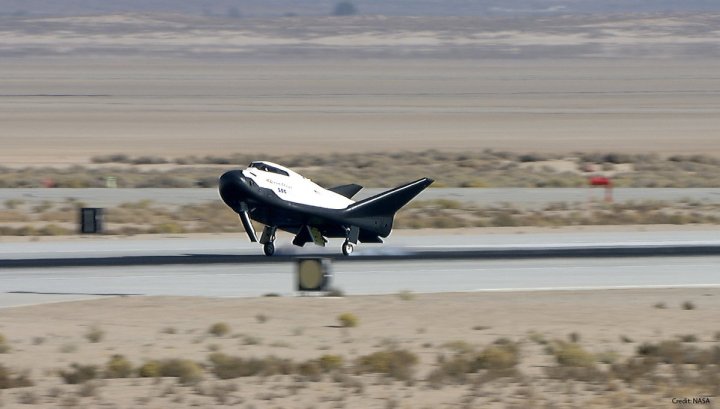
The success of the flight test likely marks the last milestone for a $227.5 million contract awarded to Sierra Nevada in 2012 for NASA’s Commercial Crew Integrated Capability (CCiCap) program.
The test had been long-planned but not publicly announced, according to Space Flight Now. The spacecraft was tethered to a heavy-duty helicopter with a 200-foot cable and released at an altitude of approximately 10,000 feet. Its on-board guidance system lined up the spacecraft with the runway during the steep final approach.
SNC is proud to announce the Dream Chaser® spacecraft had a successful free-flight test today @EdwardsAFB, with support of @NASAArmstrong. The Dream Chaser had a beautiful flight and landing! pic.twitter.com/lAn0n7FPsg
— Sierra Nevada Corporation (@SierraNevCorp) November 12, 2017
In August, the Dream Chaser was flown through the air for more than two hours during a captive-carry test while attached to a helicopter.
As Geek Wire notes, Sierra Nevada landed a different contract last year to use the Dream Chaser as an unmanned vehicle to transfer cargo back and forth to the International Space Station. A fully working version of the Dream Chaser could start making deliveries as soon as 2020, if all goes according to schedule. The company also has a contract with the United Nations to launch payloads into orbit on the Dream Chaser.
The Dream Chaser itself has an interesting and rather convoluted history. It was based on a secret Soviet design from the Cold War that turned into NASA’s HL-20, which never made it into space. A company called SpaceDev resurrected the design, but after its founder left to form a space tourism company, SpaceDev was purchased by Sierra Nevada in 2008.
Since then, they’ve had an on-again off-again relationship with NASA. Sierra Nevada got funding in 2012 under the CCiCap program, which paid out certain amounts as the spacecraft successfully completed several milestones.
In 2014, the space agency announced it would only fund the Dream Chaser rival programs, SpaceX’s Dragon and Boeing’s CST-100 spacecraft, for Commercial Crew Transportation Capability (CCtCap). Sierra Nevada filed a protest, but the government’s General Accounting Office upheld the decision.
The Dream Chaser was redesigned for cargo missions and in 2016, NASA announced that Sierra Nevada (along with SpaceX and a new company named Orbital ATK) would all be used for cargo missions to the space station in the upcoming future.
The first actual spaceflight of the Dream Chaser is planned for 2020. It will lift off atop a United Launch Alliance Atlas 5 booster from Cape Canaveral, and will touch down on the runway at the Shuttle Landing Facility at NASA’s Kennedy Space Center in Florida.


